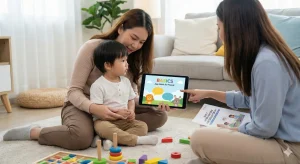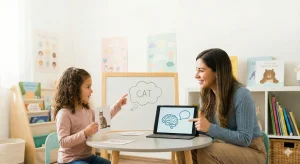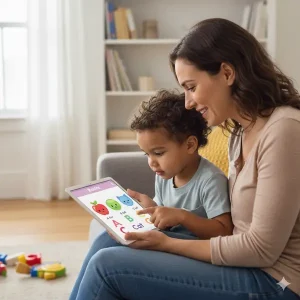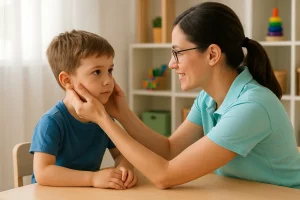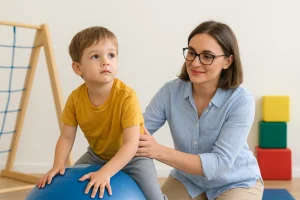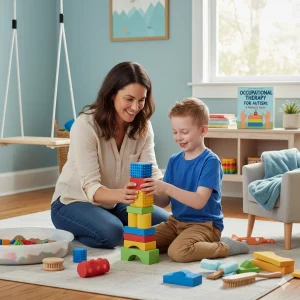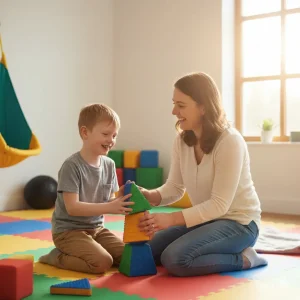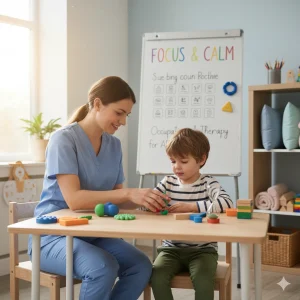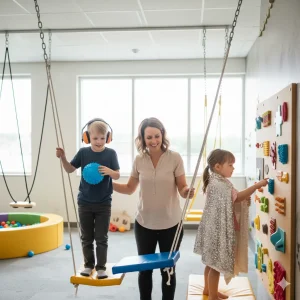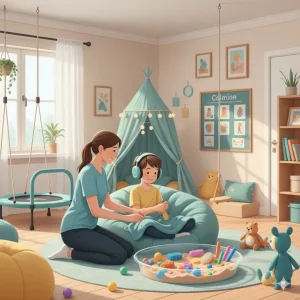Occupational Therapy for 3-Year-Olds: Skill-Building Play
By Wellness Hub
Last Updated: October 15, 2025
When your child turns three, the world suddenly becomes a playground full of learning opportunities. This is where occupational therapy for 3-year-olds can make a big difference. Occupational therapy helps preschoolers build the everyday skills they need to grow—like holding a crayon, zipping up a jacket, feeding themselves, or calming their big emotions. At this age, fine motor, sensory, and self-care skills develop rapidly, and simple OT activities for 3 year olds can turn everyday play into powerful skill-building moments. The best part? You don’t need fancy equipment or a clinic—just a few minutes of fun at home can help your little one build confidence, independence, and readiness for preschool.
What Is Occupational Therapy and Why It Matters at Age 3
For many parents, the term occupational therapy can sound a bit technical or even confusing. After all, when we think of “occupations,” we imagine jobs—not playtime. But in pediatric occupational therapy, a child’s “occupation” is exactly that: playing, learning, and building everyday skills needed to grow and thrive.
At age three, children are rapidly learning how to use their hands, bodies, and senses to interact with the world. They’re figuring out how to hold a crayon, eat with a spoon, dress themselves, and follow simple routines. Occupational therapy supports this crucial stage of development by gently guiding these skills through fun, play-based activities. Rather than “teaching” in a formal way, OT uses hands-on, engaging experiences that help children strengthen their fine motor skills, improve sensory processing, and gain confidence in daily living tasks.
This is also a key window for early intervention OT. Research shows that developmental milestones at age 3—like stable pencil grasp, self-feeding, dressing, and early pre-writing—lay the foundation for later academic and social success. When children receive support at this age, small challenges can be addressed early, preventing bigger difficulties later on.
Parents often notice concerns around this time, such as:
- Difficulty holding crayons or small objects
- Trouble dressing or managing buttons and zippers
- Sensory sensitivities—such as being bothered by textures, sounds, or movement
- Challenges with attention, transitions, or following routines
With pediatric occupational therapy, these everyday struggles are approached in a warm, playful, and practical way. Whether it’s through finger painting, water play, dressing games, or sensory exploration, OT helps your child strengthen the skills they need to become more independent, confident, and ready for preschool.
Parent Tip: If your child finds certain daily tasks tricky, it doesn’t necessarily mean something is wrong. A little structured play and early support can make a big difference in how easily they master these important skills.
Key Developmental Milestones for 3-Year-Olds
Every stage of childhood brings its own exciting leaps, but age 3 is one of the most important periods for growth and independence. At this stage, children are busy exploring, experimenting, and gaining control over their little bodies and big emotions. Understanding developmental milestones at age 3 helps parents support their child’s growth with confidence — and know when a little extra help may be useful.
These preschool skills form the foundation for learning, playing, and self-care. They don’t need to be mastered overnight, but gentle guidance and everyday play can help your child develop at their own pace.
Also read: Is Your 1-Year-Old Delayed? Occupational Therapy for 1-Year-Old
Fine Motor & Prewriting Skills
Around age three, fine motor development takes a big step forward. Children start learning how to use their hands with more control and purpose. You might notice your child:
- Holding a crayon or marker using their fingers rather than a full fist
- Imitating simple lines, circles, and crosses
- Stacking blocks, stringing large beads, or turning pages of a book one at a time
- Beginning to snip with safety scissors
These early skills build the foundation for later prewriting and classroom readiness. Strengthening hand muscles through play—like squeezing playdough, lacing, tearing paper, or drawing—helps your child get ready for writing and other daily tasks.
Sensory Regulation
Three-year-olds are learning to make sense of the world through their senses—touch, sound, movement, and sight. Sensory regulation is the ability to manage and respond to sensory input in a calm and organized way. At this age, children may:
- Enjoy messy play like water, sand, or finger painting
- Seek movement by running, spinning, or climbing
- Start tolerating different textures in clothing and food
- Need help calming down after strong sensory experiences
Supporting sensory development through everyday play can help children build focus, body awareness, and emotional control.
Self-Care Skills
Age three is a big step toward independence. Many children begin to:
- Feed themselves with a spoon or fork
- Drink from an open cup
- Pull on pants or a T-shirt with some help
- Wash their hands with reminders
- Show interest in toileting or start early potty training
These self-care skills don’t just build independence—they also boost your child’s confidence and prepare them for preschool routines.
Social-Emotional Skills
As your child’s language and understanding grow, so does their social-emotional development. Three-year-olds begin to:
- Play alongside or with other children
- Take turns with guidance
- Express their feelings with simple words
- Start showing empathy, like comforting a friend who’s sad
This is also an age when big emotions can feel overwhelming, so consistent routines and calm guidance help children feel secure as they learn to manage their feelings.
Parent Tip: Not every child develops at the exact same pace. These milestones offer a helpful guide, but what matters most is steady progress and a nurturing environment. If your child is struggling in one area—such as fine motor skills, sensory regulation, or self-care—early support through play and gentle strategies can make a real difference.
Fine Motor Activities for 3-Year-Olds to Build Hand Strength & Coordination
One of the most important developmental skills at age three is fine motor control — the ability to use small muscles in the hands and fingers to complete everyday tasks. Strengthening these skills early helps children learn to feed themselves, dress more independently, and eventually write with confidence. The good news? It doesn’t require complicated tools or expensive toys. Simple, playful fine motor activities for 3 year olds can make a powerful impact on hand strength, coordination, and confidence.
Through OT toddler activities, therapists and parents focus on playful experiences that build hand strength and dexterity. These skills are the foundation for later academic abilities like writing, cutting, and drawing, as well as everyday self-care tasks.
Playdough Squeezing & Rolling
A classic activity with big benefits. Squeezing, pinching, and rolling playdough helps strengthen the small muscles in a child’s hands and fingers. Encourage your child to:
- Roll long “snakes” or little “balls”
- Press playdough with their fingertips
- Use simple tools like plastic knives or cookie cutters
This fun sensory activity supports finger isolation, coordination, and pre-writing readiness.
Beading and Lacing
Threading large beads onto strings or using lacing cards develops hand-eye coordination and finger control. These hand strength and dexterity activities help children learn to use both hands together — a key skill for tasks like dressing, tying, or holding paper steady while writing. Start with larger beads for success, then gradually move to smaller ones as your child’s control improves.
Prewriting Lines and Shapes (| — ○ + ×)
Before children can write letters, they must first learn how to make simple prewriting strokes. Practicing lines, circles, crosses, and X-shapes helps build the foundational motor patterns needed for handwriting. Use crayons, chalk, or even finger painting to make it fun. Don’t worry about perfection — it’s about exposure and muscle memory.
Simple Scissor Skills and Paper Tearing
Cutting with safety scissors introduces hand separation (the ability to use thumb, index, and middle fingers separately), which is essential for fine motor control. At age three, children can begin with:
- Snipping the edges of paper
- Cutting along short, straight lines
- Tearing paper to strengthen finger muscles
Always supervise closely and celebrate their effort, not just the end result.
Pencil Grasp & Prewriting Skills
A functional pencil grasp doesn’t appear overnight — it develops gradually through play and everyday use. If you’ve ever wondered how to improve pencil grasp in a 3-year-old, the secret is not just giving them a pencil but strengthening their hands through a variety of playful activities.
Children at this age are typically transitioning from a fisted grasp to a more controlled finger grasp. To support this:
- Offer short crayons or broken chalk pieces that naturally encourage proper finger placement.
- Encourage vertical surfaces like easels or walls to build shoulder stability.
- Let them draw freely and explore different strokes.
Practicing prewriting strokes for age 3 — such as lines, circles, crosses, and zigzags — builds control, coordination, and confidence. These early skills make the transition to structured handwriting much smoother in the preschool and kindergarten years.
Parent Tip: Fine motor skills grow through repetition and fun, not pressure. Short, playful sessions each day are far more effective than long, structured ones. Let your child explore, get messy, and build strength at their own pace
Know more about the “Why Does a 2-Year-Old Need Occupational Therapy“
Sensory Play Ideas for 3-Year-Olds: Supporting Regulation and Exploration
When your child is three, they’re not just learning through what they see and hear—they’re learning through every sense. Sensory play gives toddlers the chance to explore textures, movements, sounds, and sensations in a safe and meaningful way. These experiences help shape how they understand their environment and how their bodies respond to it.
Sensory play ideas for toddlers aren’t just fun—they support sensory integration, which is the brain’s ability to process and organize sensory input. For children at this age, sensory activities lay the foundation for focus, coordination, and emotional regulation. They help little ones build body awareness, balance, and confidence—skills that are essential for school and everyday life.
Tactile Play Activities
Young children love to touch, squish, pour, and explore with their hands. Tactile play gives them a safe way to engage their sense of touch while building fine motor control and self-regulation. It also encourages creativity and problem-solving.
Here are some sensory play at home ideas you can try:
- Rice or bean sensory bins: Fill a large container with dry rice, beans, or pasta. Add cups, spoons, and small toys. Pouring, scooping, and hiding objects builds hand strength and attention.
- Water play: A shallow tub of water, measuring cups, and a few floating toys can entertain and calm a child for a long time. Warm or cool water can be used to introduce different sensations.
- Finger painting: Messy play like finger painting lets your child explore texture, pressure, and temperature while also improving hand control.
These sensory bin ideas don’t just keep children engaged—they help them learn to regulate their emotions and stay focused during play.
Heavy Work & Movement Play (Proprioceptive + Vestibular)
Some of the most powerful sensory activities for 3-year-old children involve movement. Proprioceptive play (deep pressure and muscle work) and vestibular play (balance and movement) help children feel secure in their bodies. They build coordination, core strength, and help calm big emotions.
Try these simple heavy work activities for preschoolers:
- Jumping, crawling, pushing, and pulling: Pushing a box of toys, crawling through tunnels, or hopping on pillows gives great deep pressure input and builds muscle strength.
- Swinging and balancing games: Swings, rocking chairs, or balance beams provide vestibular input that improves balance and body awareness.
- Indoor obstacle courses: Use cushions, tunnels, or chairs to create a simple obstacle path. This encourages problem-solving, movement planning, and coordination.
These vestibular play ideas are excellent for children who are always on the move or need extra help calming their bodies.
Parent Tip: Sensory play doesn’t have to be complicated. A tub of water, a pile of cushions, or a box of rice can become a powerful tool for learning and regulation. Keep activities short, fun, and child-led, and you’ll see how naturally your child begins to explore and grow.
Building Self-Care Skills Through Play (ADLs)
One of the most empowering parts of growing up for any child is learning to do things “all by myself.” At age three, children begin to show a strong desire to participate in daily routines. This is the perfect stage to gently build self-care skills for preschoolers, also known as Activities of Daily Living (ADLs). These include dressing, feeding, toileting, and other everyday skills that help children become more independent and confident.
The best way to teach these skills isn’t through drills or pressure—it’s through play and daily routines. When children practice self-care during fun, low-stress moments, they build coordination, problem-solving abilities, and self-confidence at their own pace.
Dressing & Toileting Practice
Getting dressed might seem like a simple task to adults, but for a preschooler, it involves a lot of fine motor coordination, sequencing, and patience. Dressing practice can start as playful participation—letting your child zip up their jacket, pull on their socks, or try buttoning a shirt.
Here are some playful ways to support these skills:
- Zipping and Buttoning: Use dress-up clothes, jackets, or button boards to let your child practice independently. Start with larger buttons and zippers before moving to smaller ones.
- Pulling Socks and Pants: Encourage your child to push and pull clothing during daily dressing routines. It strengthens hand muscles and improves body awareness.
- Potty Training Readiness: At age three, many children begin showing signs of toileting readiness—noticing when they need to go, staying dry for longer periods, or showing interest in the potty. Consistent routines, visual supports, and patience go a long way in helping children master this important skill.
Parent Tip: Celebrate effort, not just success. Every small win—like pulling up pants or washing hands after toileting—builds confidence and independence.
Feeding Therapy Tips for Picky Eaters
Mealtime can be a joyful part of the day—or a daily struggle for many families. Picky eating is common at this age, and the way parents respond can shape how children relate to food long term. Occupational therapists often use gentle, play-based strategies to build comfort and confidence at the table.
Here are some feeding therapy tips you can try at home:
- Utensil Use: Offer child-sized spoons and forks to encourage independent eating. Practice with soft foods that are easy to scoop or stab.
- Open-Cup Drinking for Toddlers: Introduce small, lightweight cups with water to help your child learn to drink without a spout or straw. This strengthens oral-motor skills and coordination.
- Picky Eating OT Tips: Make mealtimes calm and pressure-free. Involve your child in food prep, like stirring or choosing between two options. Exposure without forcing is key—sometimes, just touching or smelling new foods is progress.
These feeding therapy tips for picky eater help children build independence, develop oral-motor control, and create positive associations with food.
Parent Tip: Remember, self-care skills take time to build. Give your child opportunities to try, make mistakes, and try again. A little patience today leads to a lot of independence tomorrow.
Play-Based Therapy Activities You Can Do at Home
You don’t need a therapy room or expensive toys to help your child grow. In fact, some of the most effective home occupational therapy ideas happen right where families spend the most time—on the floor, in the living room, or during everyday routines.
Play-based therapy activities are powerful because they build skills naturally, in ways that feel fun and meaningful to children. At age three, children learn best through play, exploration, and hands-on experiences. A few minutes of preschool OT activities at home each day can support attention, coordination, language, and emotional regulation—without making it feel like “therapy.”
Everyday Play Ideas That Build Skills
These simple, parent-led activities use what you already have at home. No special equipment needed:
- Role-Play Games: Pretend play like “kitchen,” “doctor,” or “grocery store” encourages imagination, language development, problem-solving, and social interaction. Activities like pretending to pour, stir, or “take care of a patient” build fine motor skills too.
- Matching & Sorting Tasks: Use colored blocks, household items, or toys to encourage sorting by shape, color, or size. This strengthens visual-motor skills, attention, and early math concepts.
- Simple Board Games: Games that involve taking turns, rolling dice, or matching cards are perfect for building attention span, impulse control, and social-emotional skills. Choose short, age-appropriate games to keep it fun.
These everyday skill-building games are easy to adapt to your child’s interests and can be repeated daily to strengthen important developmental skills over time.
Gross Motor & Bilateral Coordination Games
At age three, children are developing strength, balance, and coordination. Gross motor activities for 3-year-olds help build strong core muscles, body awareness, and endurance. Bilateral coordination activities—using both sides of the body together—are especially important for future skills like writing, dressing, and sports.
Here are a few playful, movement-based activities:
- Ball Play: Rolling, throwing, or catching a soft ball improves hand-eye coordination and teaches turn-taking.
- Hopscotch or Jumping Games: Jumping over soft lines, stepping between cushions, or playing mini-hopscotch helps build balance and motor planning.
- Climbing: Climbing over safe furniture, cushions, or small play structures builds core strength, confidence, and spatial awareness.
These active play ideas not only support physical development but also help children regulate their energy and emotions—a key benefit of incorporating movement throughout the day.
Parent Tip: Follow your child’s lead during play. When activities feel fun and connected, children stay more engaged and learn more effectively. A little intentional play every day can make a big difference in building foundational skills for preschool and beyond.
Calming & Regulation Strategies for Toddlers
Big feelings are a normal part of being three. Toddlers experience the world with intensity — whether it’s excitement, frustration, or sensory overload. As parents, it can be tough to watch those meltdowns unfold, but the good news is that regulation and calming strategies for toddlers can help children learn how to manage their emotions in healthy ways.
At this age, many children are still developing sensory regulation, which means they may need support to calm down or feel safe when overwhelmed. Calming strategies don’t just ease difficult moments — they also teach toddlers important self-regulation skills that set the stage for emotional resilience and focus later in life.
When parents offer gentle, predictable tools to help their children regulate, it’s called co-regulation. Through co-regulation strategies, children learn that big feelings are manageable, and they begin to build the confidence to calm themselves over time.
Deep Pressure Hugs
A simple hug can do wonders. Deep pressure touch helps the nervous system feel grounded and secure. When your toddler is overwhelmed, wrapping them in a deep, steady hug (not tight or forced) can offer comfort and signal to their body that they’re safe. Some children also respond well to gentle back pressure or squeezes on the shoulders and arms.
Weighted Lap Items
For children who need extra sensory input, weighted lap items — like a small weighted blanket, pillow, or even a soft stuffed animal — can be very calming. The gentle weight provides deep pressure input that helps the body relax, lowers sensory overload, and improves focus. This can be especially helpful during quiet activities like reading, drawing, or winding down before bedtime.
Visual Calming Routines
Young children thrive on routine. Using visual calming routines (like simple picture schedules, calm-down cards, or a step-by-step poster) gives toddlers clear, predictable cues about what happens next. This lowers anxiety, builds a sense of security, and helps children transition between activities more smoothly. A visual reminder like “Take a deep breath,” “Sit on the cushion,” or “Ask for a hug” can guide them toward calm without extra words during stressful moments.
Calm-Down Corners
Creating a calm-down corner at home gives your child a safe, cozy place to rest, reset, and regulate. This isn’t a “time out” space — it’s a comfort zone. You can include soft cushions, a favorite blanket, sensory toys, books, or calming visuals. The goal is to make it inviting, not isolating. Over time, toddlers learn to associate this space with safety and calm, helping them build independence in managing their emotions.
Parent Tip: Regulation doesn’t happen overnight. Toddlers need patient, loving support to learn how to calm their bodies and emotions. When parents model calm breathing, use gentle voices, or offer sensory tools, children gradually learn to do the same on their own.
When to Seek Professional Occupational Therapy Support
Every child develops at their own pace, and small differences are a normal part of growing up. But sometimes, those differences become noticeable enough that parents start to wonder if a little extra support might help. That’s where pediatric occupational therapy can make a meaningful difference.
While many skills can be supported through everyday play and home routines, there are times when professional guidance offers children the extra boost they need to thrive. Early intervention OT is especially powerful because it addresses challenges during critical developmental windows, helping children build skills more effectively and confidently.
Recognizing the Signs Your Child Might Need OT
It’s important to remember that needing OT doesn’t mean something is “wrong” with your child. It simply means they may benefit from specialized strategies to support their growth. Here are some signs a child needs OT that parents may notice around age three:
- Ongoing difficulty with fine motor tasks (holding crayons, using utensils, stacking blocks)
- Trouble dressing, zipping, or managing buttons despite practice
- Sensory sensitivities — easily overwhelmed by textures, sounds, or movement
- Avoiding messy play or being overly sensitive to touch
- Struggling to follow simple routines or transition between activities
- Frequent meltdowns or difficulty calming down
- Limited attention span for age-appropriate activities
- Delays in self-care skills like feeding or toileting
If one or more of these signs feel familiar, talking to a pediatric occupational therapist can help you better understand your child’s needs.
Why Early Intervention Matters
One of the biggest advantages of early intervention OT is timing. At age three, the brain is developing rapidly and is highly responsive to new learning. Early support can:
- Strengthen fine and gross motor skills
- Improve sensory processing and regulation
- Build self-care skills and daily independence
- Support emotional development and confidence
- Reduce frustration and ease daily routines
When children receive targeted OT strategies early, progress often happens faster and feels more natural. Instead of “fixing” a problem later, early therapy builds a strong foundation before challenges become bigger barriers.
Parent Tip: Trust your instincts. If you sense your child is struggling with everyday skills or sensory experiences, seeking help doesn’t mean labeling—it means supporting them early so they can thrive.
Conclusion
Play is more than just fun—it’s how children learn best. At age three, play-based learning builds important skills like fine motor control, self-care, sensory regulation, and emotional growth. Simple activities like stacking blocks, pretend play, and drawing can support occupational therapy at home. You don’t need fancy tools—just a few minutes of daily play can make a big difference. With early support, children grow more confident and independent. OT for toddlers helps turn everyday moments into learning opportunities. Explore the BASICS app for easy, fun activities that support your child’s development through play. Start small—play builds big skills.
Frequently Asked Questions:
1. What is occupational therapy for 3-year-olds?
Occupational therapy helps young children build essential life skills through structured play. At this age, therapy focuses on developing fine motor skills, sensory regulation, and daily living abilities like dressing and feeding. It supports your child’s confidence, independence, and readiness for preschool.
2. How can occupational therapy help my child at home?
You don’t need fancy tools to support your child. OT activities for toddlers can be done right at home using everyday play—like drawing, stacking blocks, and role-playing. These activities build coordination, focus, and emotional regulation while keeping play fun and stress-free.
3. What are common signs my child may need OT?
Signs a child needs OT may include difficulty with pencil grasp, dressing, feeding, or managing sensory input like loud sounds or textures. Some children may struggle with focus or routines. Early support from a pediatric occupational therapist can help your child catch up and thrive.
4. What fine motor skills should a 3-year-old have?
By age three, children typically can hold crayons using their fingers, stack blocks, turn book pages, feed themselves, and snip paper with safety scissors. If your child struggles with these fine motor skills, gentle occupational therapy can make daily activities easier and more enjoyable.
5. How can I improve my child’s pencil grasp at home?
You can support pencil grasp activities with simple tools like broken crayons, chalk, or playdough. Activities like finger painting, squeezing, and drawing lines or shapes help build strength and control. This makes learning to write easier later on.
6. What are some easy sensory play ideas for toddlers?
Sensory activities for 3-year-olds help children explore their world. Try rice bins, water play, finger painting, or crawling games. These activities improve attention, sensory processing, and body awareness while keeping children engaged and happy.
7. How do I teach self-care skills like dressing and feeding?
Self-care skills for preschoolers grow through everyday routines. Let your child practice zipping jackets, pulling on socks, buttoning, and feeding themselves with utensils. Start slow, offer help when needed, and celebrate their efforts to build confidence.
8. How can I calm my toddler during meltdowns?
Regulation and calming strategies for toddlers include deep pressure hugs, quiet spaces, or visual calming routines. A calm-down corner or weighted lap item can also help. These tools give your child a sense of safety and help them manage big feelings.
9. When should I seek professional occupational therapy support?
You may consider pediatric occupational therapy if your child consistently struggles with fine motor skills, sensory sensitivities, or everyday tasks like dressing or feeding. Early intervention often leads to faster progress and prevents bigger challenges later.
10. How does play help children learn?
Play-based learning is how toddlers make sense of their world. Through stacking, role-play, and hands-on activities, they build fine motor, sensory, and emotional skills. Just 10–15 minutes of purposeful play each day can make a big difference in development.
About Author:
Sonali Sharma, Occupational Therapist
Sonali Sharma is a skilled Occupational Therapist at Wellness Hub, with over three years of experience in supporting children with developmental, behavioral, and learning challenges. She holds a Bachelor’s in Occupational Therapy (BOT) from Amity University and has worked with leading institutions such as NIMHANS Bengaluru and ESIC Hospital Faridabad.
At Wellness Hub, Sonali provides online occupational therapy sessions tailored to each child’s needs. She specializes in pediatric therapy, autism support, sensory integration, and developmental skill-building, helping children strengthen motor skills, improve focus, and become more independent in daily life.
Her therapy style is child-centered, play-based, and evidence-driven—making sessions both effective and enjoyable for kids. Sonali also equips parents with practical home therapy strategies to extend progress beyond sessions.
Passionate about empowering families, Sonali believes in creating a nurturing space where children can thrive while parents feel supported every step of the way.
Book your Free Consultation Today
Parent/Caregiver Info:
Client’s Details:
* Error Message
